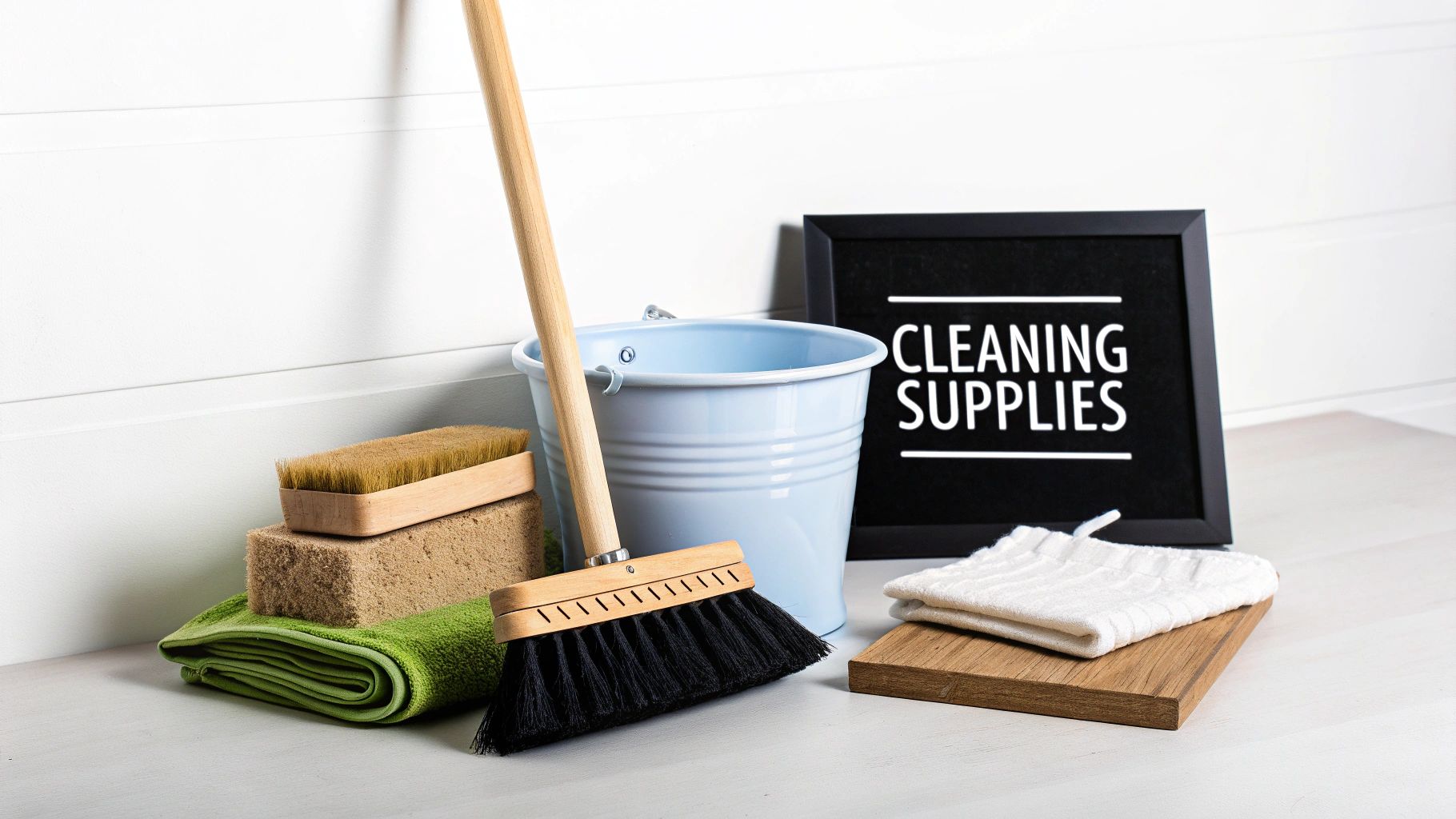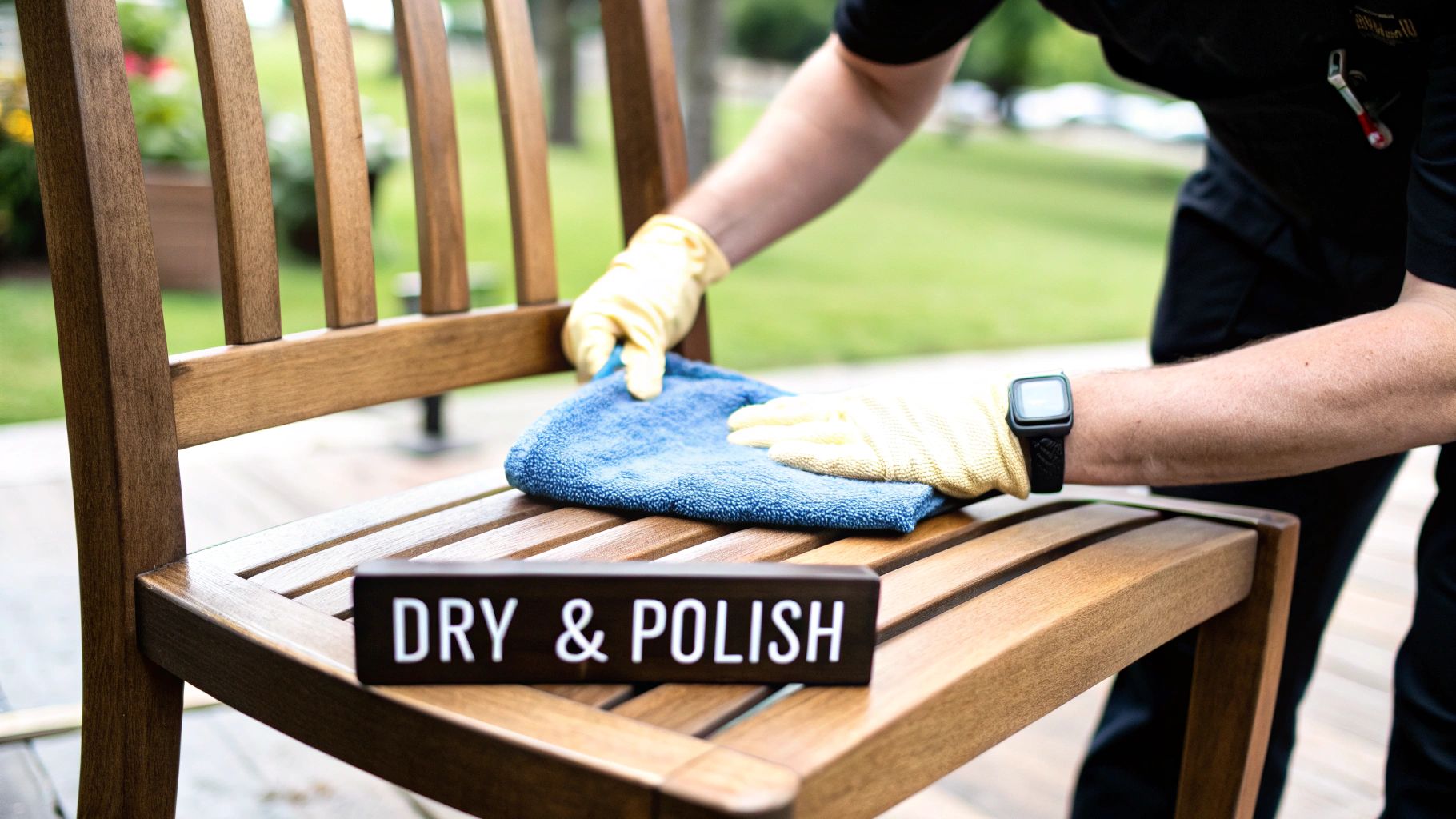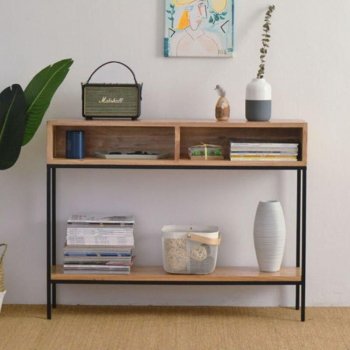How to Clean Wood Furniture: Expert Tips for a Sparkling Finish

For day-to-day upkeep, keeping your wood furniture clean is simpler than you might think. A quick pass with a microfiber cloth to grab dust, followed by a slightly damp cloth with a little mild dish soap for any grime, is all it takes. The most important part? Always dry the surface completely afterward to stop water from causing damage and to keep the wood’s natural beauty shining through.
Your Quick Guide to Pristine Wood Furniture
Learning how to clean wood furniture properly is about more than just a quick wipe-down. It's about protecting the life and luster of the pieces you love. This basic routine is your go-to for daily and weekly care, and it’s the foundation for any deeper cleaning you might do down the road.
Think of it as a simple, effective habit that keeps your furniture looking its best. Consistent dusting and gentle cleaning are the cornerstones of great wood care.
Establishing a Simple Cleaning Rhythm
The best strategy always starts with frequent dusting. I've found that getting rid of surface dust and grit every few days—or at least once a week—is non-negotiable. A good microfiber cloth is perfect for this. This simple habit prevents tiny particles from grinding into the finish and creating micro-scratches over time. It's a small effort that pays off big in the long run.
For anything stickier than dust, a mild cleaning solution is your best friend.
The real secret to a safe clean is using as little water as possible. A cloth that's too wet can make the wood swell, warp, or even develop ugly dark spots. Always wring it out until it’s just barely damp before you even think about touching the furniture.
Once you’ve wiped away the grime, there’s one final step you can't skip: drying. Grab a separate, clean, soft cloth and immediately buff the surface dry. This is the key to preventing water damage and restoring that beautiful, natural shine.
For those of you looking to furnish a new space or upgrade your current setup, checking out a curated selection of quality wood furniture can give you some great ideas for pieces worth protecting.
This two-part process—a gentle wash followed by a thorough dry—is the fundamental way to clean wood furniture without causing damage. It handles the most common types of everyday dirt and helps maintain the integrity of your wood's finish for years.
Essential Wood Cleaning Materials Checklist
Before you start, it helps to have all your tools ready to go. Having the right materials on hand makes the job quicker and ensures you won't accidentally grab something that could harm your furniture.
| Item | Purpose | Best Type |
|---|---|---|
| Microfiber Cloths | Dusting & Drying | High-quality, lint-free (at least two) |
| Mild Dish Soap | Cleaning solution base | A gentle, dye-free liquid soap |
| Small Bowl | Mixing the solution | Any small kitchen bowl will do |
| Soft Cotton Cloths | Wiping & Polishing | Old t-shirts or soft towels work great |
This simple kit is all you really need for 99% of your routine wood cleaning tasks. Keep these items together, and you'll always be prepared for a quick and effective clean.
Choosing Your Cleaning Supplies Wisely
Picking the right products for cleaning your wood furniture is a crucial step. Honestly, it's the difference between keeping your pieces beautiful for years and accidentally ruining the finish. The wrong cleaner can strip away the protective layer, leaving the wood looking dull and feeling vulnerable.
That's why knowing what's what in the world of cleaners is so important. For everyday dusting, your best friend is a high-quality microfiber cloth. I can't stress this enough. The tiny fibers are specifically designed to grab onto dust particles instead of just shoving them around. This simple switch prevents those tiny micro-scratches that build up over time and rob your furniture of its shine.
Commercial Cleaners vs. DIY Solutions
Walking down the cleaning aisle can feel a bit overwhelming, right? The global market for wood cleaners is projected to reach an incredible $5.5 billion by 2025, which tells you just how many options are out there. If you want to dive deeper into market trends, check out this detailed report on archivemarketresearch.com.
When you're looking at commercial products, the key is to read the label carefully. You're looking for cleaners made specifically for wood, preferably with a pH-neutral formula. Steer clear of all-purpose cleaners; their chemical makeup is often too harsh for a delicate wood finish.
On the other hand, you don't always need a store-bought solution. For routine cleanups, a simple DIY mix often does the trick. A classic recipe is equal parts white vinegar and water. It’s fantastic for cutting through light grime or greasy fingerprints, especially on modern furniture with a sealed finish.
Crucial Tip: Never, ever use a vinegar solution on antique, unfinished, or waxed wood. The acid in the vinegar is too aggressive and can eat away at these more delicate surfaces. When you're in doubt, a professionally formulated product is always the safer bet.
Here’s my most important piece of advice: always test a new cleaner first. Whether it's a store-bought spray or your own DIY mix, find a small, hidden spot to try it out—like the back of a leg or the underside of a tabletop. Apply the cleaner, wipe it off, and let it dry completely. This little test is your best defense against a costly mistake, ensuring it won't discolor or damage the finish before you tackle the whole piece.
Mastering Your Everyday Cleaning Method

When it comes to keeping wood furniture looking its best, moving beyond a quick swipe is essential. A truly effective cleaning routine is all about the right technique. It’s less about what you use and more about how you use it to protect your investment for the long haul.
It all starts with proper dusting. Please, forget about pushing dust around with a dry feather duster or rag. That common mistake just drags fine grit across the finish, creating tiny, subtle scratches that slowly dull the surface over time.
Instead, grab a microfiber cloth and get it just slightly damp. This is the secret. The dampness helps the fibers trap and lift away dust particles, rather than just moving them somewhere else.
The Gentle Wash and Dry Technique
For those times when a deeper clean is needed, your method is everything. Let's say you've mixed up a gentle cleaning solution with a bit of mild dish soap and water. The application is where the magic happens.
Dip a clean, soft cloth into your solution and wring it out until it’s almost dry to the touch. I can't stress this enough: excess moisture is the number one enemy of wood furniture.
Using your barely damp cloth, always wipe in the direction of the wood grain. Think of it as following the wood's natural pattern. This simple step helps the cleaner work into the tiny crevices and prevents unsightly streaks from forming.
The Most Overlooked Step: The final buff. As soon as you finish wiping a section down, immediately go over it with a separate, completely dry microfiber cloth. This whisks away any lingering moisture and buffs the surface to a clean, natural sheen. Don't let water sit, not even for a minute.
This approach is easy to adapt. A sticky dining table might need a bit more gentle pressure, while a delicate antique bookshelf will only need the lightest touch.
Building these simple habits is the key to fantastic furniture care. If you're looking for more advice on keeping your whole home sparkling, you might find our other expert cleaning guides helpful.
Your goal is to build a consistent, gentle routine. Mastering this everyday method is the single most effective way to learn how to clean wood furniture and ensure your favorite pieces stay beautiful for years to come.
Tackling Tough Stains and Grime
Sometimes, a quick wipe-down just won’t do the trick. Life happens, and with it comes sticky residue from a kid's art project, stubborn water rings from a forgotten glass, or dried-on food that seems fused to the finish. When you’re up against these tougher messes, you need a more targeted approach—one that gets the job done without damaging the wood.
For those frustratingly sticky spots, like the gunk left behind by a price tag, your secret weapon is often mineral spirits (sometimes called white spirits). Just put a small amount on a clean, soft cloth and gently work it over the sticky area. You'll feel the residue start to dissolve. It’s a real lifesaver on most modern varnishes, but always be gentle.
Here's a look at the right way to apply any cleaning solution or stain remover to wood.

As you can see, wiping with the grain isn't just a suggestion; it's a fundamental technique that protects the wood's finish during both cleaning and stain removal.
Removing Common Furniture Stains
One of the most common—and dreaded—blemishes is the cloudy white ring left by a cold, sweaty glass. You might be surprised to learn that a little bit of non-gel white toothpaste can be your best friend here.
Put a dab of the toothpaste on a soft cloth and gently rub the white ring, always moving with the wood grain. The mild abrasive in the toothpaste helps lift the moisture that's become trapped in the finish. The key is to be patient and use a light touch. Rubbing too hard can scuff the surface. Once the ring is gone, wipe the spot with a clean, damp cloth and buff it dry.
Dark spots, however, are a completely different animal. These usually mean moisture has soaked through the finish and stained the wood itself, which is a much more serious problem.
Different stains call for different solutions. Knowing what to grab can save you a lot of time and potential heartache.
Common Wood Stains and Removal Methods
| Stain Type | Recommended Cleaner | Application Technique |
|---|---|---|
| White Water Rings | Non-gel white toothpaste | Apply a small amount to a soft cloth and gently rub with the grain. |
| Sticky Residue | Mineral spirits | Dab onto a cloth and gently rub the affected area until the residue dissolves. |
| Grease or Oil | Mild dish soap and water | Mix a few drops of soap in warm water, apply with a cloth, and wipe clean. |
| Ink Marks | Isopropyl alcohol | Lightly dampen a cotton swab and gently blot the ink stain, being careful not to spread it. |
Remember, these are starting points. The type of wood and its finish will always play a role in how well a method works.
The cardinal rule of stain removal: always test your method on an inconspicuous spot first. The underside of a table, the back of a furniture leg—anywhere that's out of sight. This simple check ensures you won't accidentally discolor or damage your finish before tackling a visible area.
By methodically working through these tough spots, you can bring your furniture back from the brink of a mishap and keep your favorite pieces looking fantastic for years to come.
Bringing Out the Best in Your Wood: Polishing and Protecting

This is where the real magic happens. After you've cleaned away the surface grime, polishing is what gives your wood that deep, lustrous shine while adding a vital layer of protection. A lot of people mix up cleaning and polishing, but they play very different roles.
Think of it this way: cleaning is just maintenance for daily life. Polishing is like giving the wood a spa treatment—it feeds the grain and shields it from whatever comes next. This is the step that takes a piece from just being clean to being truly cared for.
Choosing the Right Polish
Walking down the cleaning aisle can be overwhelming, and grabbing the wrong polish can do more harm than good. They generally fall into three camps:
- Oil-Based Polish: These are fantastic for thirsty, dry-looking wood. They soak in and nourish the grain, giving it a healthy, natural glow from within.
- Wax-Based Polish: For a tougher, more durable finish, you can't beat wax. It creates a hard protective barrier that seals the wood and provides a rich, satin sheen that can last for months.
- Silicone-Based Polish: You’ll often find these in aerosol sprays that promise a quick, high-gloss shine. The problem is they can build up over time, creating a hazy, almost greasy film that’s a nightmare to remove and can prevent future refinishing efforts.
Personally, I almost always stick with high-quality oil or wax polishes for the best long-term results. It seems many agree, as the demand for proper wood care is booming. The global furniture polish market is projected to grow from $22.9 billion in 2023 to a staggering $37.8 billion by 2030. That's a huge jump, showing just how much people want to protect their furniture investments. You can dig into the numbers in this insightful market report on globenewswire.com.
Expert Polishing Tip: Less is more. A very common mistake is over-polishing, which only leads to a dull, cloudy build-up. You really only need to polish your furniture a few times a year, not every time you dust.
When it's time to polish, put a small amount onto a clean, soft cloth—never squirt it directly onto the wood. Gently work it into the surface, always moving with the grain. Then, grab a second clean cloth to buff away any excess until you get that brilliant, warm shine.
This final touch separates a quick wipe-down from a true restoration, ensuring your most cherished pieces look their absolute best. If you're looking for furniture worthy of this kind of care, you might find some new favorites in our home and garden collections.
Common Wood Care Questions Answered
Even when you feel like you've got the hang of it, a few questions always seem to surface when it comes to caring for wood furniture. Getting these sorted is the final step to feeling truly confident in your routine. Let’s clear up some of the most common things people ask.
The big one we always hear is about frequency. How often should you really be cleaning your wood pieces? It honestly depends on what kind of cleaning you're doing.
- Dusting: Aim for at least once a week. If you have pets shedding or live in a place that gathers dust easily, you might need to do it more often. This isn't just for looks; it stops tiny particles from building up and scratching the finish.
- Deep Cleaning: A proper wash-down with a gentle soap solution is only needed every few months, or when you have to tackle a spill or some built-up grime.
- Polishing: This is definitely a "less is more" situation. If you overdo it, you'll get a cloudy, sticky film that’s a magnet for dust. Stick to polishing your furniture just one or two times a year.
Can You Use an All-Purpose Cleaner?
I know it’s tempting to grab that one spray bottle you use for everything, but for the love of your furniture, please don't. The short answer to whether you can use an all-purpose cleaner on your wood table is a hard no. Those cleaners are packed with harsh chemicals, ammonia, or abrasives meant for tough grease and soap scum.
On a wood finish, those ingredients are destructive. They can strip away the protective lacquer or varnish, leaving the wood looking dull, feeling dry, and wide open to damage. Your best bet is always a product made specifically for wood or our simple soap and water method.
When you're dealing with older, more valuable pieces, the game changes. The goal with antiques isn't just cleaning; it's preservation. Being too aggressive can strip away their character and tank their value.
So, what’s the safest way to clean a precious antique? The golden rule is that less is always more. Start by just dusting with a soft, natural-bristle brush—a clean paintbrush is perfect for gently getting into carvings and details without applying pressure.
For any actual cleaning, forget the soap and modern products. Just use a soft cloth lightly dampened with distilled water, and make sure you dry it off immediately. If the antique has an old wax finish, the best protection is a specialized paste wax, applied very sparingly about once a year. If you're ever in doubt, it's always worth consulting a professional restorer.
At escalone.com, we believe beautiful furniture deserves the best care. Explore our curated collection of high-quality home goods and find pieces you’ll cherish for a lifetime. Visit https://escalone.com to discover your next favorite find.


















Leave a comment